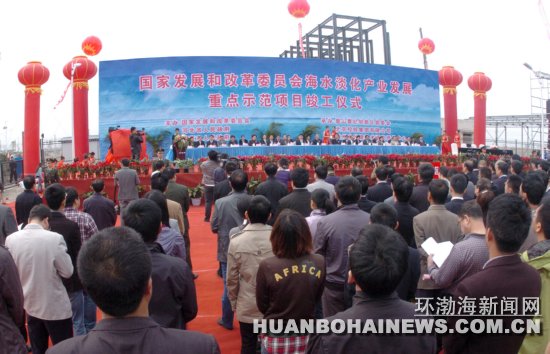Water-starved Beijing looks to the sea

BEIJING -- Working overtime in Beijing's central business district, graphic designer Chen Jiao reacts stoically to the prospect of purified seawater coursing through her taps. “I suppose I'd still drink it,” she said. “I can't to tell it apart from other kinds of water anyway.”
A water desalinisation plant located in Caofeidian, about two hours drive east of Beijing, is expected to start providing millions of tons of seawater to the city within the next five years, according to local reports.
Angry officials
Beijing is in dire need of new sources of water. The city's water reserves per person stand at just a tenth of the international “danger threshold” set by the UN, while Beijing's reservoirs are less than ten percent full. Beijing's government currently imports one third of its drinking water from neighboring Hebei province. But Hebei is also running out of water, and local government officials are angry about the meager compensation they receive for giving up their water to the capital. "We have to reduce water supply in Hebei to deliver water to Beijing," one official told the China Daily newspaper.
Beijing has pinned its hopes on a massive water diversion project, which is set to transport water from the Yangtze river in Southern China. But that project has been delayed until at least 2014, and severe droughts afflicting southern China this summer cast doubt on whether the project can really supply Beijing with the millions of tons of water it requires. That leaves the city with little option but to turn to the sea.
The world's largest market
Five years ago, Caofeidian was in unremarkable outcrop of sand in the Bohai Sea, a few hours drive east of Beijing. Since then a vast land reclamation project has created space for a deep sea port, steel and electricity plants, as well as a desalinisation plant. The plant opened this month, and currently produces 50,000 tons of potable water each day. Within a year daily production could reach a million tons.
The plant is part of nationwide government-backed expansion of water desalinisation in China. China currently produces about 600,000 tons of desalinised water every day, but the head of the Chinese Desalinisation Association said that China plans to quadruple that number by 2020. “China will probably be the world's largest market for desalinisation by 2020,” said Jennie Peng, a water industry analyst at business research firm Frost & Sullivan.
The Chinese government will invest 20 billion RMB ($3.1 billion) in seawater desalination in the coming five

years, according to a report in Shanghai Securities News. Government support also means desalinisation projects get easier access to financing. The Caofeidian plant received loans from China's central bank at specially lowered interest rates, according to water consultancy Global Water Intelligence.
Non-Chinese technology
Non-Chinese companies have captured a big slice of the desalinisation market. Nearly 80 percent of China's desalinisation plants currently use non-Chinese technology, Gao Congjie, a desalination expert at the Chinese Academy of Engineering said. China's current largest desalinisation plant, in the city of Tianjin, uses technology designed by Israeli firm IDE. The plant in Caofeidian depends on technology supplied by Aqualyng, a Norwegian company.
Foreign companies are uncertain about the best way to access the Chinese market. One option is to agree to a one-off payment for selling technology, which is appears to have been the route taken by Israeli firm IDE for the plant in Tianjin. Foreign companies China's water sector formerly favored the so-called Build-Operate-Transfer model, which gives foreign firms the right to build and operate water facilities for a set number of years, before transferring them to the government. Norwegian Company Aqualyng entered in to a joint venture with the Beijing Water Enterprises Group before investing in the Caofeidian plant, allowing them to avoid the requirement to transfer their assets.
Foreign firms may not enjoy their technological advantage for long. “By 2020, China hopes that 90 percent of the desalinisation technology will be domestically produced,” Peng said. Two government funded desalinisation research institutes have been founded in the cities of Tianjin and Hangzhou. Joint ventures with foreign firms are part of the same strategy. “Joint ventures often require the transfer of technology, or the relocation of production to China,” Peng said.
The government's ultimate aim is to make China into a major exporter of desalinisation equipment. China has a long way to go: so far it has exported just two desalinisation plants to other countries, both of which went to Indonesia. Despite China's ambitions, foreign firms still have role to play for at least the next few years. “In the short term I think more and more non-Chinese companies will be entering the Chinese market,” Peng said.
More carbon emissions
Low water prices in China make it hard for desalinisation plants to run at a profit. In Beijing, household water prices are set by the city government at three RMB per ton, while the Caofeidian plant produces water at a cost of around six RMB per ton. The story is the same in other parts of China. “These plants will need government subsidies to be profitable,” Peng said.
Costs of desalinisation in China are increased by the polluted state of China's seas, and the fact that seas in Northern China freeze up in the winter. “Cleaning and warming up the water is a major expense,” said Wang Shichang, an expert on desalinisation at Tianjin University. “But the main cost is still comes from electricity.” Electricity accounts for an estimated thirty percent of each plant's expenses, and the electricity is likely to be generated by coal-fired power stations. “Of course, [the plant's] electricity consumption means more carbon emissions, but the total emissions may be less than large scale water diversion projects,” Wang said.
The water situation in Beijing is so grave that Beijing's government may have no option than to swallow the high costs of desalinisation. According to calculations by Chinese NGO Green Earth Volunteers, Beijing consumed about 10 million tons of water per day in 2009. That means that even if the Caofeidian plant provided all its future water output to Beijing, it could only provide for a tenth of the city's current water consumption. If Beijing does start to rely on desalinisation to meet its appetite for water, then its going to need a lot more plants like Caofeidian.
Photos: Southern Weekend; Huanbohai News
This post was originally published on Smartplanet.com
